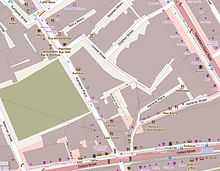Rathbone Place

.jpg)
Rathbone Place is a street in central London that runs roughly north-west from Oxford Street to Percy Street. it is joined on its eastern side by Percy Mews, Gresse Street, and Evelyn Yard. The street is mainly occupied by retail and office premises.
History
The street was originally known as Glanville Street.[1]
Inhabitants
The essayist and critic William Hazlitt lived at number 12 from 1799 to 1803.[2]
The music-hall publisher Henri D'Alcorn was based in Rathbone Place: at no. 22A in 1855–7, no. 18 in 1857–60 and no. 8 in 1860–67.
Buildings
On the east side, Number 11 is a grade II listed terraced house. The house was built around 1718-20 and refronted in the nineteenth century. The ground floor is now commercial premises.[3]
On the same side is the The Wheatsheaf public house at number 25 which became one of the principal gathering-places of London's bohemian set before the Second World War and where customers included Dylan Thomas.
On the western side of the street was the former Royal Mail depot that is being redeveloped by Great Portland Estates into a mix of residential, office and retail units.[4][5]
References
| Wikimedia Commons has media related to Rathbone Place. |
- ↑ "Rathbone Street", Survey of London, Volume 21, The parish of St Pancras part 3: Tottenham Court Road & Neighbourhood. 1949. British History Online. Retrieved 13 November 2014.
- ↑ Williams, George G. Assisted by Marian and Geoffrey Williams. (1973) Guide to Literary London. London: Batsford, p. 315. ISBN 0713401419
- ↑ List entry Number: 1265266. English Heritage. Retrieved 7 November 2014.
- ↑ Great Portland Estates to develop £550m Rathbone Place project. Chloe Stothart & Tom Fitzpatrick, Construction News, 16 October 2013. Retrieved 7 November 2014.
- ↑ Rathbone Square. Great Portland Estates. Retrieved 12 November 2014.